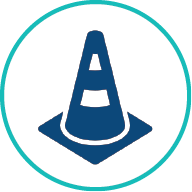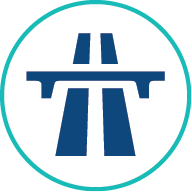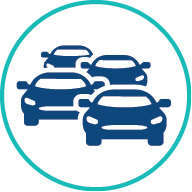In April 2025, the Commonwealth Transportation Board updated the transportation vision. Please check the pages on the Mid-term Needs, Long-term Risks & Opportunities, and Strategic Actions to see how OIPI is making progress towards that vision.
Our Transportation Vision
The first critical piece is Commonwealth Transportation Board's (CTB) vision, goals, and objectives. These goals and objectives inform the identification and prioritization of transportation needs and help identify long-term risks and opportunities.Commonwealth Transportation Board’s Vision
- Virginia’s best-in-class multimodal transportation system provides safe and reliable mobility, connects people and commerce, fosters economic growth and investment, embraces environmental stewardship, and enhances quality of life.
Guiding Principles
Guiding Principles describe an organization’s beliefs and philosophy about quality assurance and performance improvement. The principles guide the organization’s actions and approach.
| Guiding Principles (GP) |
|---|
| GP1: Promote Safety, Security, and Resiliency Provide a safe transportation system for all users that is responsive to short-term events such as weather or security emergencies and adapts effectively to long-term issues (e.g., resiliency). |
| GP2: Optimize Return on Investments Implement the right solution at the right price to meet identified needs while advancing long-term prosperity and livability. |
| GP3: Deliver Programs Efficiently Deliver high-quality projects and programs in a cost-effective and timely manner. |
| GP4: Implement Operational Improvements and Demand Management First Optimize the capacity of the transportation network by managing the demand through increased use of technology and operational improvements before investing in major capacity expansions. |
| GP5: Ensure Transparency, Accountability, And Promote Performance Management Work with stakeholders in developing transportation plans and programs. Establish performance targets, measure progress, and adjust programs and policies as necessary. |
| GP6: Enhance Coordination Between Transportation and Land Planning Inform and advise local governments to ensure coordination between local land planning and potential impacts on transportation. |
| GP7: Ensure Efficient Intermodal Connections Provide seamless connections between modes of transportation. |
| GP8: Maintenance First Maintain the current system to the agreed-upon performance standards at the lowest life-cycle cost. |
Goals and Objectives
The VTrans Goals support the VTrans Vision. They are critical in measuring progress towards the Vision and identifying transportation needs that can help us achieve it.
| Goals | Objectives |
|---|---|
 Goal A: Transportation System Safety Goal A: Transportation System Safety Reduce fatalities and serious injuries to make the transportation network safer for the traveling public | Objectives:
|
 Goal B: System Preservation Goal B: System Preservation Provide well-maintained and managed transportation infrastructure and services across the Commonwealth. | Objectives:
|
 Goal C: Economic Competitiveness through Travel Time Reliability: Goal C: Economic Competitiveness through Travel Time Reliability: Encourage economic competitiveness and prosperity by improving travel time reliability by minimizing congestion and considering modal options. | Objectives:
|
 Goal D: Inter-Connected Systems and Services Goal D: Inter-Connected Systems and Services Provide an integrated multimodal transportation system for better accessibility and travel options. | Objectives:
|
 Goal E: Environmental Stewardship Goal E: Environmental Stewardship Provide transportation solutions that enhance the quality of life while preserving agricultural, natural, historical, and cultural resources. | Objectives:
|
Frequently Asked Questions (FAQs)
Looking for more specific information about VTrans? Find more information on our Frequently Asked Questions page here: https://vtrans.virginia.gov/get-involved/frequently-asked-questions


